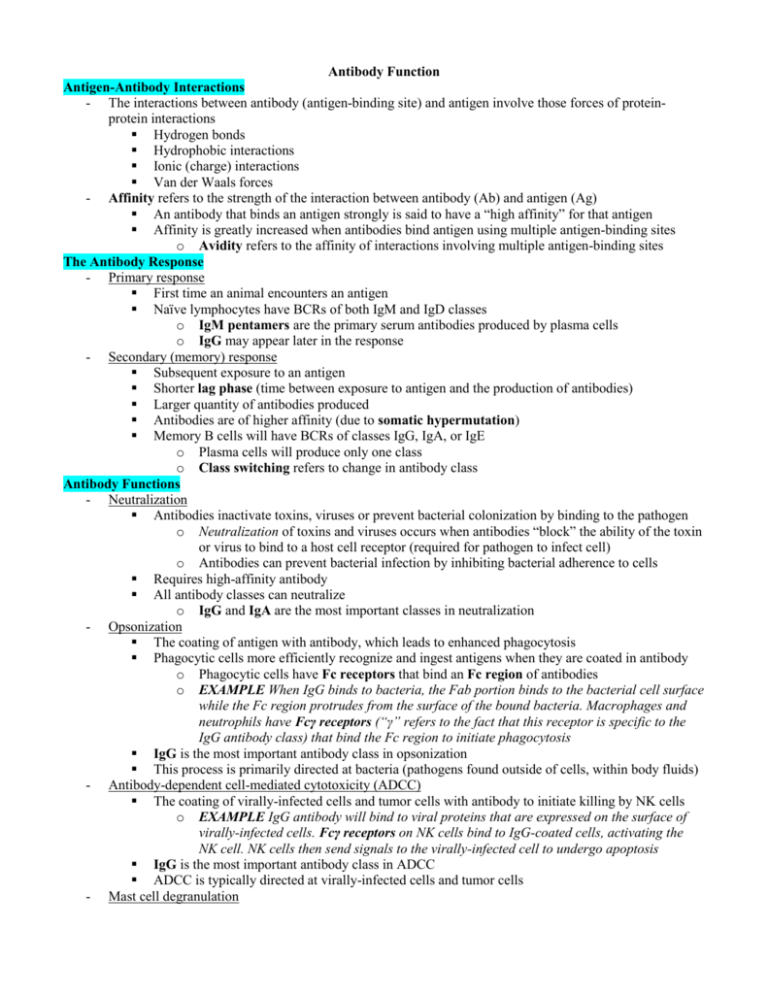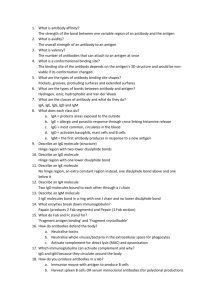4_Antibody function - V14-Study
advertisement

Antibody Function Antigen-Antibody Interactions - The interactions between antibody (antigen-binding site) and antigen involve those forces of proteinprotein interactions Hydrogen bonds Hydrophobic interactions Ionic (charge) interactions Van der Waals forces - Affinity refers to the strength of the interaction between antibody (Ab) and antigen (Ag) An antibody that binds an antigen strongly is said to have a “high affinity” for that antigen Affinity is greatly increased when antibodies bind antigen using multiple antigen-binding sites o Avidity refers to the affinity of interactions involving multiple antigen-binding sites The Antibody Response - Primary response First time an animal encounters an antigen Naïve lymphocytes have BCRs of both IgM and IgD classes o IgM pentamers are the primary serum antibodies produced by plasma cells o IgG may appear later in the response - Secondary (memory) response Subsequent exposure to an antigen Shorter lag phase (time between exposure to antigen and the production of antibodies) Larger quantity of antibodies produced Antibodies are of higher affinity (due to somatic hypermutation) Memory B cells will have BCRs of classes IgG, IgA, or IgE o Plasma cells will produce only one class o Class switching refers to change in antibody class Antibody Functions - Neutralization Antibodies inactivate toxins, viruses or prevent bacterial colonization by binding to the pathogen o Neutralization of toxins and viruses occurs when antibodies “block” the ability of the toxin or virus to bind to a host cell receptor (required for pathogen to infect cell) o Antibodies can prevent bacterial infection by inhibiting bacterial adherence to cells Requires high-affinity antibody All antibody classes can neutralize o IgG and IgA are the most important classes in neutralization - Opsonization The coating of antigen with antibody, which leads to enhanced phagocytosis Phagocytic cells more efficiently recognize and ingest antigens when they are coated in antibody o Phagocytic cells have Fc receptors that bind an Fc region of antibodies o EXAMPLE When IgG binds to bacteria, the Fab portion binds to the bacterial cell surface while the Fc region protrudes from the surface of the bound bacteria. Macrophages and neutrophils have Fcγ receptors (“γ” refers to the fact that this receptor is specific to the IgG antibody class) that bind the Fc region to initiate phagocytosis IgG is the most important antibody class in opsonization This process is primarily directed at bacteria (pathogens found outside of cells, within body fluids) - Antibody-dependent cell-mediated cytotoxicity (ADCC) The coating of virally-infected cells and tumor cells with antibody to initiate killing by NK cells o EXAMPLE IgG antibody will bind to viral proteins that are expressed on the surface of virally-infected cells. Fcγ receptors on NK cells bind to IgG-coated cells, activating the NK cell. NK cells then send signals to the virally-infected cell to undergo apoptosis IgG is the most important antibody class in ADCC ADCC is typically directed at virally-infected cells and tumor cells - Mast cell degranulation Mast cells are specialized cells of the immune system that mediate inflammatory responses via the release of substances from storage granules (degranulation) o Histamine is the most important of these inflammatory substances Mast cells have Fcε receptors that bind to IgE, which initiates the binding of IgE to antigen. Antigen-binding then causes degranulation Recruitment of eosinophils to the site of infection is important Important in the protection against parasites (helminthes) Major mechanism of allergy (type I hypersensitivity) Tends to occur near body surfaces (underneath skin, at mucous membranes) - Complement activation The complement system is a series of serum proteins that mediates host defense against various extracellular pathogens (especially bacteria) using various mechanisms o Amplifies inflammatory response Release of chemoattractants directs migration of phagocytes towards pathogen o Forms bacterial pores Pores in cell walls and membranes cause bacteria to swell with fluid and burst Both IgG and IgM antibodies can activate the complement system This process is typically directed at bacteria Antibody Distribution - Class of antibody determines its location in the body Location in body Antibody Isotype Plasma IgG, IgM (pentamer), IgA (mostly monomers) Mucosal surfaces/secretions IgA (dimers)* Submucosal tissues IgE (on mast cells) Fetus IgG B cell membrane IgM, IgD (mature B cells) IgG, IgA, IgE (memory B cells) *Due to the large surface area of mucous membranes (GI, respiratory, urinary tracts, etc.), IgA is the most produced class of antibody - Transport of secretory IgA to mucosal surfaces Secretory IgA must traverse epithelial cells of mucous membranes to reach the tract lumen o Dimeric IgA binds a polymeric Ig receptor (pIgR) on the basement membrane, undergoes transcytosis across the cell, and is released at the apical surface into the tract lumen The pIgR is mostly cleaved at the apical surface, though a remaining fragment (secretory component) may make IgA more stable within the external environment Passive Immunity - Passive immunity naturally occurs by the transfer of antibody across placenta and via colostrum Humans o Fetal immunity is mediated by placental IgG uptake by FcγRn (Fc receptor for neonates) o dIgA is the predominant antibody in colostrum Domestic animals Species Primary Placental Ig Primary Colostral Ig* IgG IgA Primate, rabbit None IgG Ruminants, pigs, horses None IgG Cat IgG IgG Dog * Though IgG is the predominant Ig found in colostrum (except in primates), there are also significant concentrations of IgA and IgM





